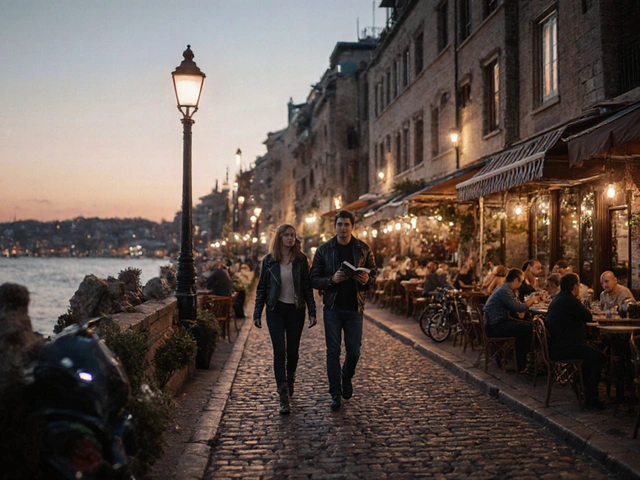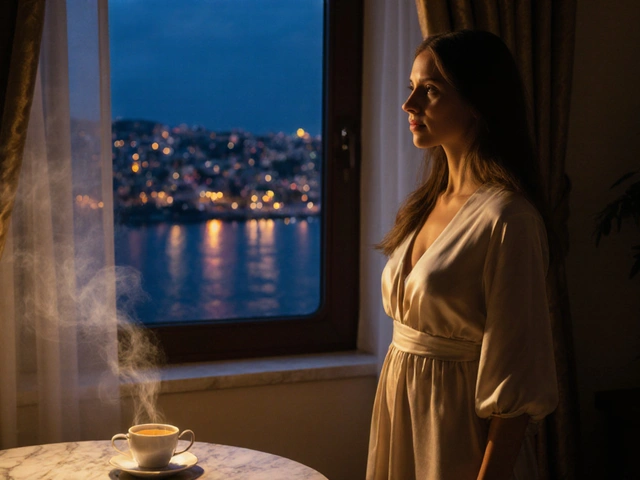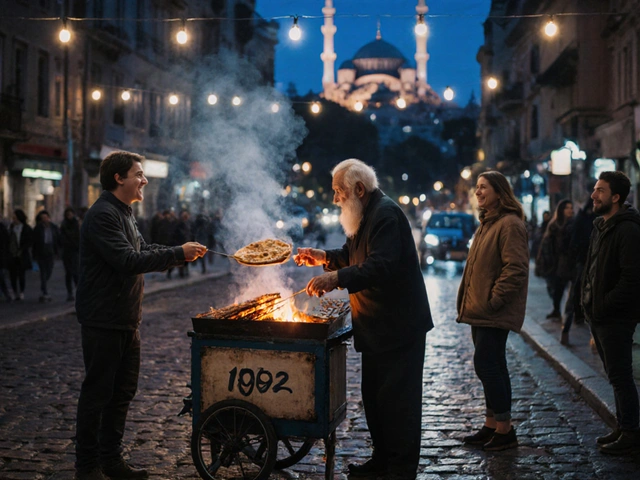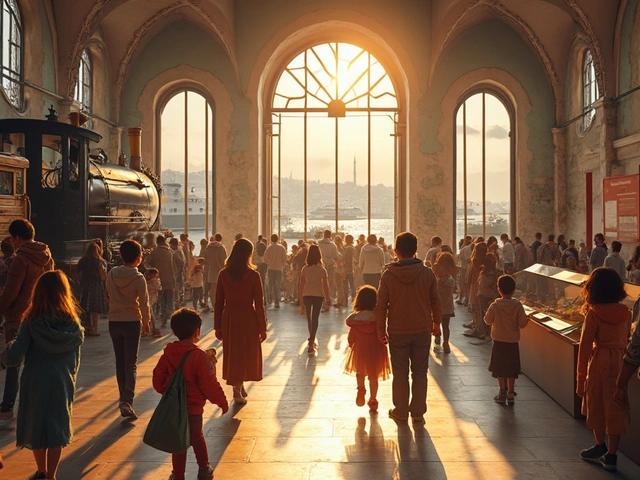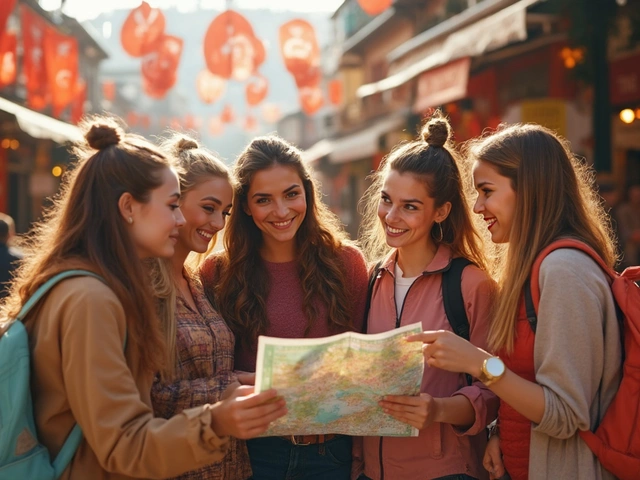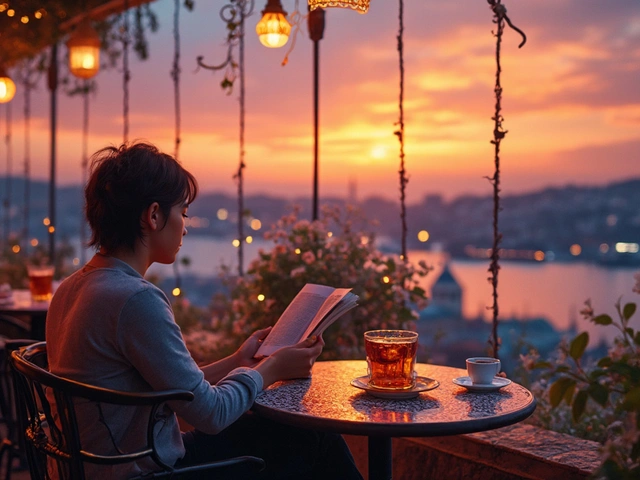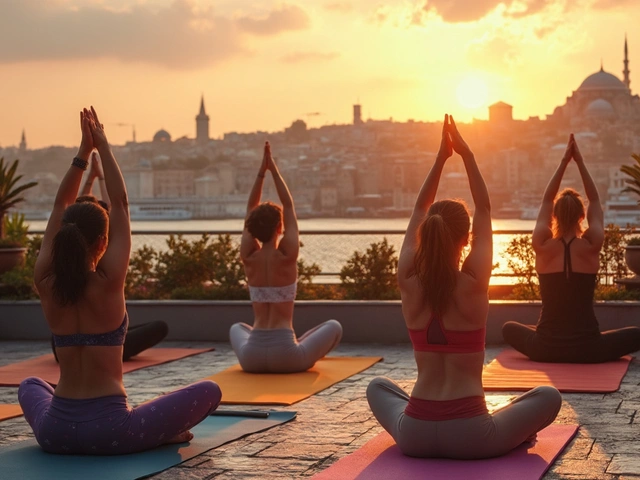Walking through Istanbul is like flipping through a living history book—each neighborhood, each street, has its own story. From the aroma of freshly baked simit outside Çırağan Palace to the echoing call to prayer from mosques perched above the Bosphorus, every sense gets a wake-up call here. Locals know that the city isn’t just about the big sites—Hagia Sophia or Topkapı Palace—but also about the tiny moments you stumble on: sharing kahve with friends in Kadıköy, joining a lively conversation in a backstreet tea house, or haggling over hand-painted ceramics at the Grand Bazaar.
If you want to get under Istanbul’s skin, start by exploring where cultures collide. Try riding the nostalgic tram on İstiklal Avenue, but then duck into a side alley where old Greek bakeries and Armenian churches still hold their ground. Don’t just snap a photo—ask the shopkeeper about the best börek in the area or what changed in the neighborhood last year. You’ll get a tip that’s better than anything in a guidebook and maybe even an invite for tea.
- Why Istanbul is a Crossroads of Cultures
- Neighborhoods That Tell Stories
- Tasting Istanbul: Where Food Meets Tradition
- Local Markets and Crafts to Experience
- Festivals, Art, and Music Around the City
- Tips for Authentic Connections in Istanbul
Why Istanbul is a Crossroads of Cultures
Istanbul has always been more than just a big city. Its location right between Europe and Asia turns it into a natural meeting point for people, ideas, and lifestyles. More than 16 million people call Istanbul home today, and the city's population is made up of not just Turks, but also Kurds, Armenians, Greeks, Jews, Syrians, and folks from all over the world. This mix isn’t a new thing— it’s been happening for centuries.
Back in the day, Istanbul was known as Byzantium, then Constantinople, before it became Istanbul. Each empire—the Greeks, Romans, Byzantines, and Ottomans—left their own touch. You see it everywhere: churches-turned-mosques like Hagia Sophia, Roman aqueducts in the middle of busy roads, Armenian bakeries sharing streets with Ottoman-era bathhouses.
If you’ve ever wondered why the street food in Istanbul feels so diverse, it’s because the city's dining table reflects its roots. Take the staple simit: some say it traces back to ancient Greek sesame bread, which over centuries gained a Turkish twist. Or look at neighborhoods like Balat, filled with synagogues, churches, and mosques sitting practically side by side.
Why does this matter for you? Because it means that every time you step outside in Istanbul, you’re entering one of the world’s oldest cultural mashups. You can have a cappuccino made by an Italian-Turkish barista in Karaköy, then shop for Persian carpets in the Grand Bazaar, and finish your day with Georgian khinkali at a family-owned restaurant in Kurtuluş. That’s just normal life here.
- 38% of Istanbul’s population were born outside the city—so newcomers are everywhere, giving the city a fresh energy.
- There are officially more than 3,000 mosques, 90 churches, and 20 synagogues in Istanbul today—many still active.
- Every year, dozens of cultural festivals celebrate this mix, like the Istanbul Biennial and Music Festival.
| Population (2025 est.) | Mosques | Churches | Synagogues | Languages Spoken |
|---|---|---|---|---|
| 16,253,000 | 3,113 | 90 | 20 | More than 30 |
Getting involved in Istanbul culture isn’t hard if you’re curious. With so many backgrounds mixing, just asking someone about their favorite dish or the story behind a celebration will probably lead to a new place or event to try. That’s what really makes Istanbul feel like a crossroads—every day brings a chance to experience something unexpected.
Neighborhoods That Tell Stories
Some neighborhoods in Istanbul just feel alive with history and personality. Take Karaköy—it used to be all about spice traders and dockworkers, but now it blends street art, artisan coffee shops, and old synagogues tucked behind bakeries. Walk ten minutes and you’ll end up at Galata Tower, surrounded by steep streets packed with music stores and vintage shops. Locals love to meet friends for meze at Karaköy Lokantası before heading over to snap photos of the Bosphorus view.
Cihangir is a favorite for artists and writers. You’ll find narrow streets lined with cozy cafés, walls covered in colorful murals, and bookstores that have been around for decades. On any given evening, you might see a film crew shooting a scene or a group of musicians creating an impromptu street concert. For anyone new to the city, it’s a welcoming spot to sit, people-watch, and soak up that creative vibe.
Step across the Golden Horn and you hit Balat and Fener, famous for their rainbow-colored houses and religious diversity. This area feels like another world, with Greek Orthodox churches, Jewish synagogues, and centuries-old mosques all just streets apart. Try the fresh pomegranate juice from a local stand while exploring. Balat’s antique shops and tiny corners hold stories waiting for anyone willing to ask a question.
Don’t skip the Asian side. Kadıköy is where locals go to eat, shop, and relax. It’s got some of the best food markets in the city, night markets, and more live music than anywhere else. Walk along Moda’s seaside or share a coffee at a fourth-generation pastry shop. In spring, the Kalamış Marina area feels like a holiday with its open-air seating and sea breeze.
If you want a real feel for Istanbul, the trick is to slow down in these neighborhoods. Walk without a map, hop into local bakeries, watch daily routines, and chat with shop owners about what’s new. Each area has a different story, and it’s often the little details—graffiti on an old wall or a café filled with regulars—that bring those stories to life.
Tasting Istanbul: Where Food Meets Tradition
Food is the heartbeat of daily life in Istanbul. What you eat and where you eat says just as much about your experience as the places you visit. Locals swear by the simit sellers who roll their carts beside the Bosphorus at sunrise, and there's a reason the line for balık ekmek near Galata Bridge never seems to get shorter. These aren’t tourist traps—they're everyday life.
Any list of Istanbul's must-try foods should start with breakfast. Turkish breakfast, or "kahvaltı," is a full adventure: fresh white cheese (beyaz peynir), olives, tomatoes, honey with thick kaymak (clotted cream), and eggs prepared menemen-style with juicy tomatoes and green peppers. Skip the hotel buffet and head to Van Kahvaltı Evi in Cihangir, where you can order the real deal. Just be ready to linger—breakfast in Istanbul isn’t rushed.
Lunch and dinner open up a world of options. Hit up a lokanta, like Kanaat Lokantası in Üsküdar or Haci Abdullah in Beyoğlu, for old-school Turkish home cooking: stews, rice, beans, stuffed eggplants, and oven-roasted lamb. For snacks, Beyoğlu’s midye dolma (stuffed mussels) stands are always busy, and a visit to an old-school baklava house—like Karaköy Güllüoğlu—turns dessert into an event. Wash it down with a shot of strong Turkish tea served in a tiny tulip glass.
If you like street food, try:
- Kokoreç (grilled spiced sheep's intestines) at Şampiyon Kokoreç.
- Lahmacun (Turkish pizza) from Borsam Taşfırın in Kadıköy.
- Kumpir (stuffed baked potato) from one of the many stalls in Ortaköy.
- Seasonal fish sandwiches right on the Bosphorus at Eminönü or Karaköy.
For a deeper dive, sign up for a culinary walking tour (Culinary Backstreets does them well), or just chat with a vendor at Kadıköy Market about which olives are the best this week. Istanbulites love to talk food and share the best spots—just ask, and someone will point you to their favorite döner stand or meyhane for traditional mezes and rakı.
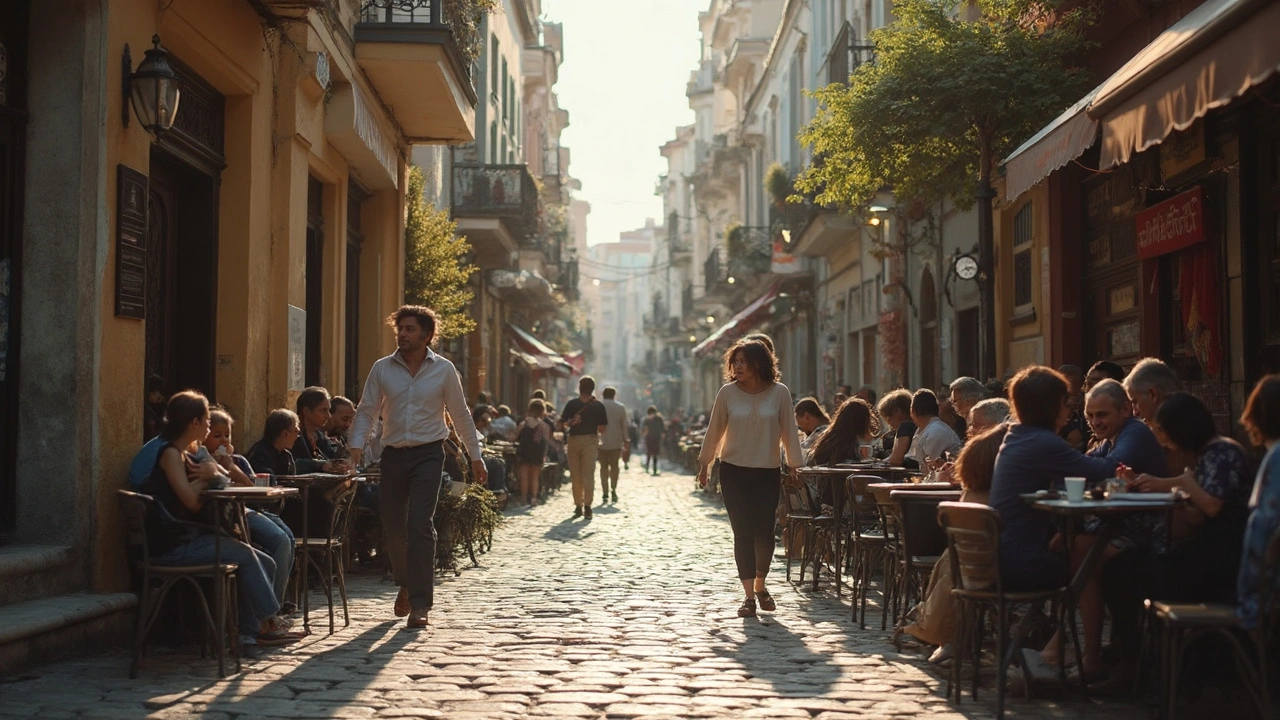
Local Markets and Crafts to Experience
If you want to see Istanbul’s heart in action, nothing beats wandering its markets. The Istanbul Grand Bazaar (Kapalıçarşı) isn’t just for souvenirs; it’s an everyday destination for locals looking for gold jewelry or a good deal on a leather bag. There are over 4,000 shops inside, making it one of the world’s largest and oldest covered markets—seriously, it dates back to 1461. Early morning visits are easier on the crowds, and don’t be shy about haggling; it’s basically expected.
For a different vibe, hit up Kadıköy Çarşı on the Asian side. This market is the real deal for fresh produce, cheese, fish, and spices. Head there before noon if you want the best deals, and definitely try the pickled veggies—locals swear by them. Another spot, the Egyptian Bazaar (Mısır Çarşısı), is packed with every spice you can think of plus Turkish delight that melts in your mouth. Shopkeepers will let you taste-test, so ask before buying.
Istanbul’s love for handicrafts shows up at Arasta Bazaar, just behind the Blue Mosque. The shops here sell handmade carpets, mosaic lamps, and İznik ceramics. If you find something you like, ask the seller about the process. Artisans here know their stuff, and a quick chat can teach you the story behind Turkish designs—like why tulip patterns pop up everywhere.
For cool crafts and gifts that feel more modern, try the hip stalls at Bomontiada or pop-up markets in Karaköy. Young designers here mix tradition with a twist, offering handmade soaps, jewelry, and quirky tote bags. Prices are usually marked, but there’s room for a little friendly bargaining if you’re buying more than one item.
- Check product labels and ask where items are made—genuine local goods are worth the extra lira.
- If you want custom work (like a name engraved on a copper coffee pot), give the artisan a day or two.
- Bring cash—small shops may not take cards, and cash can get you a better bargain.
| Market | Location | Famous For | Opening Hours |
|---|---|---|---|
| Grand Bazaar | Beyazıt, Old City | Jewelry, carpets, antiques | 9am–7pm (closed Sundays) |
| Kadıköy Çarşı | Kadıköy, Asian Side | Food, produce, street snacks | 8am–8pm |
| Egyptian Bazaar | Eminönü | Spices, sweets, tea | 9am–7pm |
| Arasta Bazaar | Sultanahmet | Ceramics, carpets | 9am–7pm |
A day spent in Istanbul’s markets isn’t just about shopping; it’s the best way to meet people and dive into stories straight from the city itself.
Festivals, Art, and Music Around the City
Istanbul’s social calendar is always packed, and honestly, there’s no shortage of events if you want to dive into the local vibe. The city’s arts scene isn’t just about ancient mosaics or museum halls; it’s just as alive in the streets, clubs, and even ferries crossing the Bosphorus.
Let’s get real about festivals first. The Istanbul International Film Festival has been running since 1982 and attracts film buffs from all over. Istanbul Biennial is a must if you even slightly care about modern art. You’ll find installations and pop-up events scattered from Karaköy to Tophane. Music never stops either: don’t miss the Istanbul Jazz Festival in July or the Akbank Jazz Fest if you love late-night gigs. For something super local, try catching a whirling dervish ceremony or pop over to the district of Kadıköy for its low-key alternative music nights.
If you’re into galleries and offbeat venues, make time for Salt Galata, Sakıp Sabancı Museum, and Pera Museum. Take the ferry across to Moda and you’ll discover indie theatres, like Moda Sahnesi, which hosts plays and experimental performances almost every week.
Local tip: Many events offer discounted entry for students or free public days—check official sites or ask around at cultural centers like Zorlu PSM, which also brings in international acts for everything from ballet to rock concerts.
- The Grand Bazaar closes at 7pm, but its side streets are filled with musicians after dark—worth a visit just for the impromptu jam sessions.
- Check out the Beyoğlu Culture Route Festival—it covers everything from classical Turkish music to rap.
- During Ramadan, special musical events happen nightly in Sultanahmet Square. Open-air food stalls make it a perfect evening for locals and newcomers.
| Festival Name | Month | Main Activity | Typical Location |
|---|---|---|---|
| Istanbul International Film Festival | April | Film Screenings | Multiple cinemas, Beyoğlu |
| Istanbul Jazz Festival | July | Live Jazz Concerts | Harbiye Cemil Topuzlu, various |
| Istanbul Biennial | September-November (odd years) | Contemporary Art | Modern galleries citywide |
| Beyoğlu Culture Route Festival | October | Music, Art, Literature | Beyoğlu and surroundings |
| Ramadan Evenings | Varies (March-April) | Music, Food | Sultanahmet Square |
If you’re hunting unique souvenirs, shop local at festival markets. Artists and musicians often sell DIY records, paintings, or handmade crafts straight from stalls. Follow official Instagram pages or ask your favorite café about what’s coming up next weekend—plans change fast here, and word-of-mouth gets you into the most authentic experiences.
Tips for Authentic Connections in Istanbul
If you want to really connect with Istanbul, it helps to skip the touristy routines and dive into the local life. People here are genuinely curious about visitors but also love when someone makes an effort to blend in. You'll start to feel included a lot quicker if you learn a few Turkish phrases: even a simple “Merhaba” (hello) or “Teşekkürler” (thank you) goes a long way. Folks appreciate it when you ask about their story or let them teach you something about their home city.
Getting involved in community spaces makes a big difference. Try visiting a local semt pazarı (neighborhood market), like the Tuesday market in Kadıköy or Bomonti Organic Market in Şişli. These aren’t just places to buy fresh veggies but little hubs of chatter and daily life. Vendors remember faces, and you might get better prices or an extra bunch of parsley thrown in if you keep coming back.
Food is probably the fastest way to break through any barriers. Istanbulites love to share, so if you’re invited for breakfast or dinner at someone’s home, it’s a big deal. Show up with something small in hand—a box of baklava from Karaköy Güllüoğlu is always welcome. If you want to eat out but still keep it local, avoid crowded chains and look for esnaf lokantası (tradesmen’s restaurants), where the daily dishes change but the hospitality stays the same.
- Spend time in local çay bahçesi (tea gardens) like Moda Çay Bahçesi or Emirgan Sütiş—people-watching, chatting, and playing backgammon is how friendships spark here.
- Public art workshops pop up in neighborhoods like Balat and Yeldeğirmeni, especially on weekends. Don’t be shy to join—they’re less about talent, more about getting together.
- If you hear live music pouring out from a meyhane (tavern) in Kumkapı or Cihangir, step inside. Even without knowing the songs, you’ll be clapping and singing by the end of the night.
- Check out local organizations like Yabangee, which organize meetups, tours, and language exchanges tailored to expats and locals looking to mingle.
Surprisingly, recent data from Istanbul Metropolitan Municipality shows that over 35% of residents regularly engage in community activities outside work or school—so odds are, someone in your neighborhood is also looking to connect. Here’s a snapshot of popular spots and events that help people meet:
| Activity | Location | Best Time to Join |
|---|---|---|
| Street Food Crawl | Karaköy & Beyoğlu | Weekends, evenings |
| Open-Air Film Night | Siyah Beyaz Senkron, Kadıköy | Summer |
| Neighborhood Festival | Kuzguncuk Bostanı | Spring & autumn |
| Group Hike | Belgrad Forest | Spring, early autumn |
| Language Exchange | Taksim, various cafes | All year |
If you remember just one thing about making Istanbul your home or second home: say yes more often. Whether someone invites you for tea or out to a soccer match, these moments create the most real connections here.


